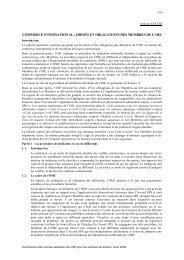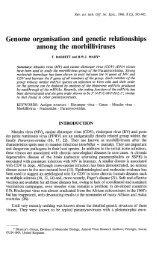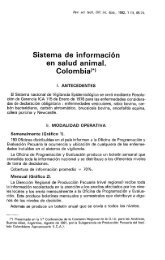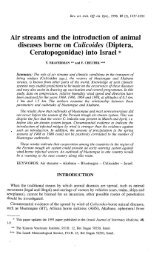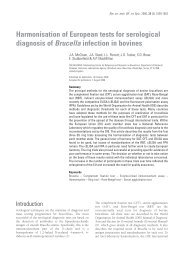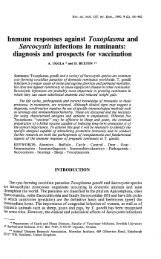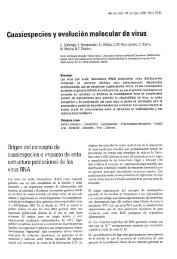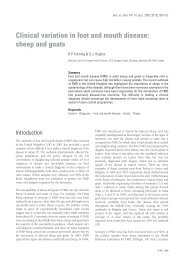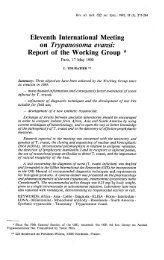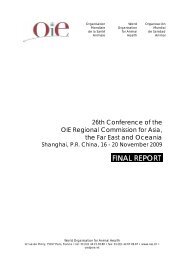ENZOOTIC BOVINE LEUKOSIS - OIE
ENZOOTIC BOVINE LEUKOSIS - OIE
ENZOOTIC BOVINE LEUKOSIS - OIE
Create successful ePaper yourself
Turn your PDF publications into a flip-book with our unique Google optimized e-Paper software.
NB: Version adopted by the World Assembly of Delegates of the <strong>OIE</strong> in May 2012<br />
CHAPTER 2.4.11.<br />
<strong>ENZOOTIC</strong> <strong>BOVINE</strong> <strong>LEUKOSIS</strong><br />
SUMMARY<br />
Description of the disease: Enzootic bovine leukosis (EBL) is a disease of cattle caused by the<br />
bovine leukaemia virus (BLV), a member of the family Retroviridae. Cattle may be infected at any<br />
age, including the embryonic stage. Most infections are subclinical, but a proportion of cattle<br />
(~30%) over 3 years old develop persistent lymphocytosis, and a smaller proportion develop<br />
lymphosarcomas (tumours) in various internal organs. Natural infection has also been recorded in<br />
water buffaloes and capybaras. Clinical signs, if present, depend on the organs affected. Cattle with<br />
lymphosarcomas almost invariably die either suddenly, or weeks or months after the onset of<br />
clinical signs.<br />
Identification of the agent: Virus can be detected in the culture supernatant following in-vitro<br />
culture of peripheral blood mononuclear cells (PBMC) from infected animals, by BLV antigen<br />
detection, by polymerase chain reaction (PCR) or by electron microscopy. Proviral DNA can also be<br />
detected in PBMC or tumours of infected animals by PCR.<br />
Serological tests: The antibody detection methods widely used are the agar gel immunodiffusion<br />
(AGID) assay using serum and the enzyme-linked immunosorbent assay (ELISA) using serum or<br />
milk. These tests have formed the basis for successful eradication policies in many countries. Other<br />
tests, such as radio-immunoassay, can also be used. A number of AGID and ELISA kits are<br />
commercially available.<br />
Requirements for vaccines: No vaccine against BLV is available.<br />
A. INTRODUCTION<br />
There may be several causes of lymposarcomas in cattle, but the only definitely known cause is the retrovirus,<br />
bovine leukaemia virus (BLV), which causes enzootic bovine leukosis (EBL). The term sporadic bovine leukosis<br />
(SBL) is usually reserved for young animals (calves) as well as cutaneous and thymic types of lymphoma, which<br />
is defined by the age of the animal affected and the distribution of the tumours. The cause of SBL is not known.<br />
There may also be lymphosarcomatous conditions that do not fall into either the SBL or EBL categories, i.e. adult<br />
multicentric lymphoma with sporadic occurrence of unknown aetiology. Only lymphomas caused by BLV infection<br />
should be termed leukosis or enzootic bovine leukosis (Gillet et al., 2007).<br />
Although animals can become infected with BLV at any age, tumours (lymphosarcomas) are seen typically in<br />
animals over 3 years of age. Infections are usually subclinical; only 30–70% of infected cattle develop persistent<br />
lymphocytosis, and 0.1–10% of the infected animals develop tumours. Signs will depend on the site of the<br />
tumours and may include digestive disturbances, inappetance, weight loss, weakness or general debility and<br />
sometimes neurological manifestations. Superficial lymph nodes may be obviously enlarged and may be palpable<br />
under the skin and by rectal examination. At necropsy, lymph nodes and a wide range of tissues are found to be<br />
infiltrated by neoplastic cells. Organs most frequently involved are the abomasum, right auricle of the heart,<br />
spleen, intestine, liver, kidney, omasum, lung, and uterus. The susceptibility of cattle to persistent lymphocytosis,<br />
and perhaps also to tumour development, is genetically determined.<br />
There is conflicting evidence of the role of the virus in immunological dysfunctions or in increased culling rates.<br />
Two large-scale investigations estimated the mean decline in milk production per cow among test-positive BLV<br />
herds compared with test-negative herds as very similar at 2.5% and 2.7%, respectively (Emanuelsson et al.,<br />
1992; Ott et al., 2003). In addition, a 7% lower conception rate in BLV test-positive cows compared with testnegative<br />
cows has been reported. Increased culling rates and a greater susceptibility to other diseases with<br />
infectious aetiology, e.g. mastitis, diarrhoea and pneumonia were also demonstrated among test-positive BLV<br />
<strong>OIE</strong> Terrestrial Manual 2012 1
Chapter 2.4.11. — Enzootic bovine leukosis<br />
herds (Emanuelsson et al., 1992). Therefore despite no obvious clinical signs during the long subclinical infection<br />
period, economic losses caused by persistent BLV infections seem to be relevant.<br />
Virus can be detected by in-vitro cultivation of peripheral blood mononuclear cells (PBMC). The virus is present in<br />
PBMC and in tumour cells as provirus integrates into the DNA of infected cells. Virus is also found in the cellular<br />
fraction of various body fluids (nasal and bronchial fluids, saliva, milk). Natural transmission depends on the<br />
transfer of infected cells, for example during parturition. Artificial transmission occurs, especially by bloodcontaminated<br />
needles, surgical equipment, gloves used for rectal examinations etc. Lateral transmission in the<br />
absence of these contributory factors is usually slow (Monti et al., 2005). In regions where blood-sucking insects<br />
occur in large numbers, especially tabanids, these may transmit the virus mechanically. Viral antigens and<br />
proviral DNA can be identified in semen, milk and colostrum of infected animals (Dus Santos et al., 2007; Romero<br />
et al., 1983). Natural transmission through these secretions, however, has not clearly been demonstrated.<br />
Although several species can be infected by inoculation of the virus, natural infection occurs only in cattle (Bos<br />
taurus and Bos indicus), water buffaloes, and capybaras. Sheep are very susceptible to experimental inoculation<br />
and develop tumours more often and at a younger age than cattle. A persistent antibody response can also be<br />
detected after experimental infection in deer, rabbits, rats, guinea-pigs, cats, dogs, sheep, rhesus monkeys,<br />
chimpanzees, antelopes, pigs, goats and buffaloes.<br />
BLV was probably present in Europe during the 19th century, from where it spread to the American continent in<br />
the first half of the 20th century. It may then have spread back into Europe and introduced into other countries for<br />
the first time by the import of cattle from North America (Johnson & Kaneene, 1992). A number of countries are<br />
recognised as officially free from BLV infection.<br />
Several studies have been carried out in an attempt to determine whether BLV causes disease in humans,<br />
especially through the consumption of milk from infected cows (Burmeister et al., 2007; Perzova et al., 2000).<br />
There is, however, no conclusive evidence of transmission, and it is now generally thought that BLV is not a<br />
hazard to humans.<br />
1. Identification of the agent<br />
B. DIAGNOSTIC TECHNIQUES<br />
BLV is an exogenous retrovirus and belongs to the genus Deltaretrovirus within the subfamily Orthoretrovirinae<br />
and the family Retroviridae. It is structurally and functionally related to the primate T-lymphotropic viruses 1, 2 and<br />
3 (STLV-1, -2, -3) and human T-lymphotropic virus[es] 1 and 2 (HTLV-1 and -2). The major target cells of BLV are<br />
B lymphocytes (Beyer et al., 2002; Gillet et al., 2007). The virus particle consists of single-stranded RNA,<br />
nucleoprotein p12, capsid (core) protein p24, transmembrane glycoprotein gp30, envelope glycoprotein gp51, and<br />
several enzymes, including the reverse transcriptase. Proviral DNA, which is generated after reverse transcription<br />
of the viral genome, integrates randomly into the DNA of the host cell where it persists without constant<br />
production of viral progeny. When infected cells are cultured in-vitro, usually by co-cultivation of PBMC with<br />
indicator cells, infectious virus is produced, most readily through stimulation with mitogens.<br />
a) Virus isolation<br />
PBMC from 1.5 ml of peripheral blood in ethylene diamine tetra-acetic acid (EDTA) are separated on a<br />
ficoll/sodium metrizoate density gradient, cultured with 2×10 6 fetal bovine lung (FBL) cells, and subsequently<br />
grown for 3–4 days in 40 ml of minimal essential medium (MEM) containing 20% fetal calf serum. Virus<br />
causes syncytia to develop in the cell monolayer of the FBL cells. Short-term cultures can be prepared by<br />
culturing PBMC in the absence of FBL cells in 24-well plates for 3 days (Miller et al., 1985). The p24 and<br />
gp51 antigens can subsequently be detected in the supernatant of the cultures by radio-immunoassay (RIA),<br />
enzyme-linked immunosorbent assay (ELISA), immunoblot or agar gel immunodiffusion (AGID), and the<br />
presence of the BLV particles or BLV-provirus can be demonstrated by electron microscopy and by PCR,<br />
respectively.<br />
b) Nucleic acid detection by PCR (an alternative test for international trade)<br />
The use of the polymerase chain reaction (PCR) to detect BLV provirus has been described by various<br />
workers (Beier et al., 1998; Blankenstein et al., 1998; Belak & Ballagi-Pordany, 1993; Rola & Kuzmak, 2002;<br />
Teifke & Vahlenkamp, 2008; Venables et al., 1997). Primers constructed to match the gag, pol and env<br />
regions of the genome have all been used with variable success. So far, nested PCR followed by gel<br />
electrophoresis is the most rapid and sensitive method. The methods described are based on primer<br />
sequences from the env gene, coding for gp51. This gene is highly conserved, and the gene and the antigen<br />
are generally present in all infected animals throughout the course of infection. The technique is restricted to<br />
2 <strong>OIE</strong> Terrestrial Manual 2012
Chapter 2.4.11. — Enzootic bovine leukosis<br />
those laboratories that have the facilities for molecular virology, and the usual precautions and control<br />
procedures must be in place to ensure validity of the test results (see Chapter 1.1.4/5 Principles and<br />
methods of validation of diagnostic assays for infectious diseases, and Chapter 1.1.7 Biotechnology in the<br />
diagnosis of infectious diseases and vaccine development).<br />
PCR is mainly used as an adjunct to serology for confirmatory testing. The detection of BLV infection in<br />
individual animals by PCR can be useful in the following circumstances:<br />
Young calves with colostral antibodies;<br />
Tumour cases, for differentiation between sporadic and infectious lymphoma;<br />
Tumour tissue from suspected cases collected at slaughterhouses;<br />
New infections, before development of antibodies to BLV;<br />
Cases of weak positive or uncertain results in ELISA;<br />
The systematic screening of cattle in progeny-testing stations (before introduction into artificial<br />
insemination centres);<br />
Cattle used for production of vaccines, ensuring that they are BLV free.<br />
• Sensitivity and reliability of the method<br />
i) Analytical sensitivity: Although the nested PCR assay has a theoretical sensitivities of one target<br />
molecule, in practice the analytical sensitivity is around five to ten target molecules of proviral DNA.<br />
ii) False-positive results: The high sensitivity of the nested PCR may cause problems of false-positive<br />
results due to contamination between samples (Belak & Ballagi-Pordany, 1993). To minimise this,<br />
several special procedures are adopted throughout the protocol, such as the use of laminar air-flow<br />
hoods, separate rooms for different steps of the procedure, new gloves or the use of special tube<br />
openers for each individual assay and negative controls (e.g. water blanks).<br />
iii) False-negative results: It should be noted that only a small proportion of the PBMC can be infected,<br />
thus limiting the sensitivity of the assay. The presence of inhibitory substances in some samples may<br />
cause false-negative results. To detect this, at least one positive control is used on every test run. In<br />
addition, assays should use internal controls (mimics) that are added to each sample. The mimic is a<br />
modified target molecule that is amplified with the same primers as the real target, but that generates a<br />
PCR product with different size, which can be visualised by agarose gel electrophoresis. The mimic is<br />
added at a low concentration that favours the amplification of the real target (Ballagi-Pordany & Belak,<br />
(1996). However, it is possible for the mimic to compete with the true target. It may therefore be<br />
necessary to analyse each sample with or without the mimic.<br />
• Sample preparation<br />
PBMC are separated from EDTA blood samples by using the Ficoll-Paque separation method. Alternatively<br />
buffy coat may be used, or even whole blood, e.g. where samples have been frozen.<br />
Tumours or other tissues should be homogenised to a 10% suspension.<br />
• DNA extraction<br />
Purification of total DNA is a prerequisite for achieving optimal sensitivity. Various purification methods are<br />
commercially available and suitable for the assay.<br />
Special precautions should be taken during all steps to minimise the risk of contamination (Belak & Ballagi-<br />
Pordany, 1993).<br />
• Nested PCR procedure<br />
Several PCR protocols for the detection of BLV provirus sequences have been published (Beier et al., 1998;<br />
Rola & Kuzmak, 2001; Teifke & Vahlenkamp, 2008; Venables et al., 1997). As an example, two PCR assays<br />
based on the one developed by Belak & Ballagi-Pordany et al. (1993) and the one developed by Fechner et<br />
al., 1996 are described in detail. The BLV region used as target is the gp51 (env) gene. The sequence used<br />
for designing the primers is available from GenBank, accession No. K02120.<br />
Method developed by Belak & Ballagi-Pordany (1993)<br />
<strong>OIE</strong> Terrestrial Manual 2012 3
i) Primer design and sequences<br />
Chapter 2.4.11. — Enzootic bovine leukosis<br />
Oligo Sequence Position in K02120<br />
OBLV1A (5’-CTT-TGT-GTG-CCA-AGT-CTC-CCA-GAT-ACA-3’) 5029<br />
OBLV6A (5’-CCA-ACA-TAT-AGC-ACA-GTC-TGG-GAA-GGC-3’) 5442<br />
OBLV3 (5’-CTG-TAA-ATG-GCT-ATC-CTA-AGA-TCT-ACT-GGC-3’) 5065<br />
OBLV5 (5’-GAC-AGA-GGG-AAC-CCA-GTC-ACT-GTT-CAA-CTG-3’) 5376<br />
PCR I -product size: 440 bp; PCR II -product size: 341 bp; Mimic-product size: 761 bp.<br />
ii) Reaction mixtures<br />
Reaction mixtures are blended (except DNA sample and mimic) before adding to the separate reaction<br />
tubes. One negative control (double distilled H2O) per five samples, and one positive control should be<br />
added. Total volumes of mixtures are calculated by multiplying the indicated volumes by the total<br />
number of samples, including controls, plus one. Taq polymerase is used in a premade 1/10 dilution.<br />
DNA samples and mimic 1 (Ballagi-Pordany & Belak, 1996) should be added in separate rooms in the<br />
laboratory: laboratory room 1 for DNA preparations and mimics, and laboratory room 2 for PCR II -<br />
products, to minimise contamination.<br />
a) Reagents added in clean laboratory room<br />
This mixture may be prepared in advance and stored at 4°C for up to 1 month.<br />
Reagents per reaction (conc.) PCR I reaction PCR II reaction<br />
Double-distilled H 2 O (standardised) 21 µl 21 µl<br />
10 × PCR buffer (Perkin Elmer) 5 µl 5 µl<br />
dNTP (10 mM) 4 × 1 µl 4 × 1 µl<br />
Bovine serum albumin (1 mg/ml)<br />
Primers (10 pmol/µl):<br />
5 µl 5 µl<br />
OBLV1A 1.5 µl –<br />
OBLV6A 1.5 µl –<br />
OBLV3 – 1.5 µl<br />
OBLV5 – 1.5 µl<br />
In total: 38 µl 38 µl<br />
The following should be added just before starting the PCR<br />
Reagents per reaction (conc.) PCR I reaction PCR II reaction<br />
MgCl 2 (25 mM) 5 µl 5 µl<br />
Taq polymerase (1 unit/reaction) 2 µl 2 µl<br />
Mineral oil 2 drops 2 drops<br />
In total: 45 µl 45 µl<br />
1 Available from Dr S. Belák, Department of Virology, National Veterinary Institute, Box 585, Biomedical Centre, S-751 23,<br />
Uppsala, Sweden.<br />
4 <strong>OIE</strong> Terrestrial Manual 2012
Chapter 2.4.11. — Enzootic bovine leukosis<br />
b) Reagents added in laboratory room 1 (DNA) or 2 (PCR II )<br />
Reagents per reaction (conc.) PCR I reaction PCR II reaction<br />
DNA sample* (or water*) 5 µl –<br />
PCRI product – 5 µl<br />
In total: 50 µl 50 µl<br />
iii) PCR thermoprofiles<br />
PCR I -thermoprofile<br />
5 × 94°C/45 seconds, 60°C/60 seconds, 72°C/90 seconds<br />
30 × 94°C/45 seconds, 55°C/60 seconds, 72°C/90 seconds<br />
1 × 72°C/420 seconds ≥20°C<br />
PCR II -thermoprofile<br />
5 × 94°C/45 seconds, 58°C/60 seconds, 72°C/90 seconds<br />
30 × 94°C/45 seconds, 53°C/60 seconds, 72°C/90 seconds<br />
1 × 72°C/420 seconds ≥20°C<br />
iii) Laboratory procedure<br />
Mix PCRI-reagents as described in step ii use separate gloves or tube openers for each individual tube<br />
when adding the DNA samples. Put the samples on ice. Heat the thermoblock to 80°C. Place samples<br />
in the thermoblock and start the PCR-programme (step iii).<br />
Mix PCR II -reagents as described in step ii. Use separate gloves or tube openers for each individual<br />
tube when adding the PCR I -product. Put the samples on ice. Heat the thermoblock to 80°C. Put<br />
samples in the thermoblock and start the PCR II -programme (step iii).<br />
• Agarose gel electrophoresis<br />
Take the PCR II -products to the electrophoresis laboratory. Load approximately 10–15 µl of the samples<br />
and 23 µl loading buffer on a 2% agarose gel containing 0.01% ethidium bromide (alternative, safer<br />
products are available to visualise PCR products, e.g. RedSafe TM or GelRed TM ). Using 0.5 ×<br />
Tris/borate/EDTA (TBE) buffer, electrophoresis is performed with 90 mA for 2 hours. To control the size<br />
of the amplification products, a 100 bp ladder is recommended. Analysis of PCR products is done by<br />
UV illumination.<br />
• Interpretation of the results<br />
i) Positive samples should have PCR products of the expected size (341bp), similar to the positive<br />
control.<br />
ii) Negative samples should have no PCR products of the expected size (341bp) but mimic product<br />
(144 bp) should be present.<br />
iii) Unclear results: the assay must be repeated if the positive controls (mimic or external positive control<br />
are negative, or if the negative water controls are positive.<br />
• Confirmatory testing<br />
For confirmatory identification, the PCR products can be sequenced, hybridised to a probe, or analysed<br />
by restriction fragment length polymorphism (RFLP) analysis (Fechner et al., 1997).<br />
<strong>OIE</strong> Terrestrial Manual 2012 5
Method developed by Fechner et al. (1996)<br />
i) Primer design and sequences<br />
Chapter 2.4.11. — Enzootic bovine leukosis<br />
Oligo Env-Sequence (5’–3’) Position<br />
BLV-env-1 TCT-GTG-CCA-AGT-CTC-CCA-GAT-A 5032–5053<br />
BLV-env-2 AAC-AAC-AAC-CTC-TGG-GAA-GGG 5629–5608<br />
BLV-env-3 CCC-ACA-AGG-GCG-GCG-CCG-GTT-T 5099–5121<br />
BLV-env-4 GCG-AGG-CCG-GGT-CCA-GAG-CTG-G 5542–5521<br />
The BLV-env-1/BLV-env-2 PCR-product size is 598 bp. The BLV-env-3/BLV-env-4 PCR-product size is<br />
444 bp<br />
ii) Reaction mixtures<br />
Reaction solutions are mixed (except DNA sample) before adding to the separate reaction tubes. One<br />
negative control (double distilled H2O) per five samples, and one positive control should be added.<br />
Total volumes of mixtures are calculated by multiplying the indicated volumes by the total number of<br />
samples, including controls, plus one.<br />
The first PCR can be performed using a 50 µl reaction volume. For one reaction, the assay is optimised<br />
to 5 µl (10×) PCR buffer, 20 µl DNA (~1 µg of DNA), 1.25 µl each of the env-specific primers BLV-env-<br />
1 and BLV-env-2 (20 pmol/µl), 0.15 dNTP (each 25 mM), 3 µl MgCl2 (25 mM), 0.25 µl Taq polymerase<br />
(1.25U), and 19.1 µl of distilled H2O. The reaction follows the temperature profile: 2 minutes<br />
denaturation at 94°C; 30 cycles of 30 seconds at 95°C, 30 seconds at 58°C and 60 seconds at 72°C;<br />
followed by 4 minutes at 72°C.<br />
The nested PCR can be performed using a 50 µl reaction volume. For one reaction, the assay is<br />
optimised to 3 µl PCR product of the first PCR, 5 µl (10×) PCR buffer, 1.25 µl each of the env-specific<br />
primers BLV-env-3 and BLV-env-4 (20 pmol/µl), 0.15 dNTP (each 25 mM), 0.25 µl Taq polymerase<br />
(1.25U), and 36.1 µl of distilled H2O. The reaction follows the temperature profile: 2 minutes<br />
denaturation at 94°C; 30 cycles of 30 seconds at 95°C, 30 seconds at 58°C and 60 seconds at 72°C;<br />
followed by 4 minutes at 72°C.<br />
iii) Laboratory procedure<br />
Mix PCR-reagents for the first or nested PCR and use separate gloves or tube openers for each<br />
individual tube when adding the DNA samples. Put the samples on ice. Heat the thermoblock to 94°C.<br />
Place samples in the thermoblock and start the PCR-programmes accordingly.<br />
• Agarose gel electrophoresis<br />
Load approximately 10 µl of the nested PCR products with 20 µl loading buffer on a 2% agarose gel<br />
containing 0.01% ethidiumbromide. Using 0.5 × Tris/borate/EDTA (TBE) buffer, electrophoresis is<br />
performed with 90 mA for 2 hours. To control the size of the amplification products, a 100 bp ladder is<br />
recommended. Analysis of PCR products is done by UV illumination.<br />
• Interpretation of the results<br />
i) results: Positive samples should have PCR products of the expected size (444 bp), similar to the<br />
positive control.<br />
ii) results: Negative samples should have no PCR products of the expected size (444 bp).<br />
iii) results: The assay must be repeated if the positive control remained negative, or if the negative water<br />
controls are positive.<br />
• Confirmatory testing<br />
For confirmatory identification, the PCR products can be sequenced, hybridised to a probe, or analysed<br />
by restriction fragment length polymorphism (RFLP) analysis (Fechner et al., 1997).<br />
2. Serological tests<br />
6 <strong>OIE</strong> Terrestrial Manual 2012
Chapter 2.4.11. — Enzootic bovine leukosis<br />
Infection with the virus in cattle is lifelong and gives rise to a persistent antibody response. Antibodies can first be<br />
detected 3–16 weeks after infection. Maternally derived antibodies may take up to 6 or 7 months to disappear.<br />
There is no way of distinguishing passively transferred antibodies from those resulting from active infection. Active<br />
infection, however, can be confirmed by the detection of BLV provirus by the PCR. Passive antibody tends to<br />
protect calves against infection. During the periparturient period, cows may have serum antibody that is<br />
undetectable by AGID because of an antibody shift from the dam’s circulation to her colostrum. Therefore, when<br />
using the AGID test, a negative test result on serum taken at this time (2–6 weeks pre- and 1–2 weeks postpartum)<br />
is not conclusive and the test should be repeated. However, the AGID can be performed at this stage<br />
with first-phase colostrum.<br />
The antibodies most readily detected are those directed towards the gp51 and p24 of the virus. Most AGID tests<br />
and ELISAs in routine use detect antibodies to the glycoprotein gp51, as these appear earlier. Methods of<br />
performing these tests have been published (Dimmock et al., 1987; European Commission, 2009). ELISAs are<br />
usually more sensitive than the AGID tests.<br />
Weak positive and negative <strong>OIE</strong> reference sera for use in ELISA are available in freeze-dried, irradiated form from<br />
the <strong>OIE</strong> Reference Laboratory in Germany (see Table given in Part 3 of this Terrestrial Manual). The calibration of<br />
these sera is based on the accredited <strong>OIE</strong> reference serum, named E05, which has been validated against the<br />
former reference serum E4 by different AGID and ELISAs.<br />
a) Enzyme-linked immunosorbent assay (a prescribed test for international trade)<br />
Either an indirect or blocking ELISA may be used. Assays based on both of these are available<br />
commercially; different kits may be required for serum or milk samples. Some ELISAs are sufficiently<br />
sensitive to be used with pooled samples. ELISAs are carried out in solid-phase microplates. BLV antigen is<br />
used to coat the plates either directly or by the use of a capture polyclonal or monoclonal antibody (MAb).<br />
The antigen is prepared from the cell culture supernatant of persistently BLV-infected cell lines. Fetal lamb<br />
kidney (FLK) cells are most commonly used for commercial tests (Van der Maaten & Miller, 1976). Since<br />
2004, a new BLV-producing cell line, PO714, which is free from other viral infections and contains a provirus<br />
of the Belgian subgroup, has been made available (Beier et al., 2004). The antigen is used at a<br />
predetermined dilution (e.g. 1/10) in phosphate buffered saline (PBS). In kit form, the plates are sometimes<br />
purchased precoated. Some preservatives may be added to milk samples to prevent souring. Preserved<br />
samples will not usually deteriorate significantly if stored for up to 6 weeks at 4°C.<br />
• Blocking enzyme-linked immunosorbent assay — Serum ELISA<br />
The following method is suitable for antibody detection in single or pooled serum samples.<br />
• Test procedure<br />
i) Coating the plate<br />
All wells are coated with BLV antibody, prediluted in coating buffer (100 µl/well), the plate is sealed and<br />
incubated for 18 hours at 4°C. A wash cycle (standard wash) is performed, which is three washes filling<br />
wells to the top, with a 3-minute soak in between each wash, and then the plate is blotted. BLV antigen<br />
is added, prediluted in wash buffer (100 µl/well), the plate is sealed and incubated for 2 hours at 37°C.<br />
A standard wash cycle is performed.<br />
ii) Preparation and addition of samples and controls<br />
The positive and negative control sera are prediluted (1/2) in wash buffer and the solution is added to<br />
four wells per control (100 µl/well). For testing pooled samples, 80 sera may be bulked then diluted<br />
(1/2) using wash buffer and the solution is added to two wells (100 µl/well) per sample. Single samples<br />
should be diluted 1/100 using wash buffer and the solution added to two wells (100 µl/well) per sample.<br />
After plating out the samples, the plate is sealed and incubated for 18 hours at 4°C. A brief wash is<br />
performed by filling the wells and immediately emptying them.<br />
iii) Preparation and addition of conjugates and substrate<br />
Prediluted biotinylated antibody is added (100 µl/well) to all wells – predilute using wash buffer + 10%<br />
fetal calf serum – the plate is sealed and incubated on a rocking table for 1 hour at 37°C. A standard<br />
wash is performed as described earlier. The peroxidase-conjugated avidin is prediluted in wash buffer<br />
and the solution is added to all wells (100 µl/well). The plate is sealed and incubated on a rocking table<br />
for 30 minutes at 37°C. A standard wash is performed. 100 µl orthophenylamine diamine substrate is<br />
added to all wells, the plate is covered and left in the dark for 9 minutes. The reaction is stopped with<br />
100 µl of 0.5 M sulphuric acid per well.<br />
<strong>OIE</strong> Terrestrial Manual 2012 7
Chapter 2.4.11. — Enzootic bovine leukosis<br />
• Reading and interpretation of results<br />
The plate reader is blanked on air and the absorbance is read at 490 nm. For dual wave-length readers a<br />
reference filter between 620 nm and 650 nm is used. Results are read within 60 minutes after the addition of<br />
stop solution.<br />
The absorbance of the negative control should be about 1.1 ± 0.4; if the absorbance is below 0.7, the colour<br />
development time in step iii above (preparation and addition of conjugates and substrate) should be<br />
increased. Conversely, the time should be shortened if the absorbance is above 1.5. The absorbance of the<br />
positive control should be less than the absorbance of the negative control × 0.25.<br />
A sample is positive when the absorbance of each of the two test wells is identical with or less than the<br />
mean absorbance of the four negative wells × 0.5.<br />
A sample is negative when the absorbance of each of the two test wells is identical with or higher than the<br />
mean absorbance of the four negative control wells × 0.65.<br />
For samples giving values between the absorbance of the negative control × 0.5 and × 0.65 it is<br />
recommended to retest the animal, using a sample taken 1 month later.<br />
• Sensitivity of the enzyme-linked immunosorbent assay<br />
The sensitivity of pooled milk ELISAs can be evaluated using the <strong>OIE</strong> weak positive and reference sera.<br />
Assays should give a positive result on <strong>OIE</strong> reference sera E05 diluted in negative milk 250 times more than<br />
the number of individual milks in the pool (EU Directive 88/406). For example, for pools of 60 milks, E05<br />
should be diluted 1/250 × 60 = 1/15000. For individual milk samples the positive <strong>OIE</strong> reference sera E05<br />
diluted 1/250 in negative milk must be positive.<br />
Where pooled serum samples are tested, the <strong>OIE</strong> reference serum E05 must test positive at a dilution<br />
10 times higher than the number of individual animals in the pool. For example, for a pool of 50 individual<br />
samples, the <strong>OIE</strong> reference serum diluted 1/500 in negative serum should give a positive result. In assays<br />
where serum samples are tested individually, <strong>OIE</strong> reference serum E05 diluted 1/10 must be positive.<br />
• Indirect enzyme-linked immunosorbent assay — Milk ELISA<br />
The following method is suitable for antibody detection in pooled milk samples.<br />
• Controls<br />
Strong positive, weak positive, negative milk and diluent controls should be included in each assay. A strong<br />
positive control should be prepared by diluting the <strong>OIE</strong> reference serum E05 1/25 in negative milk. A weak<br />
positive control should be prepared by diluting, in negative milk, the <strong>OIE</strong> reference serum E05 25 times the<br />
number of individual milk samples in the pool under test. The milk used for diluting the <strong>OIE</strong> reference serum<br />
controls should be unpasteurised, cream free and preserved.<br />
• Example test procedure<br />
i) Milk samples must be stored, undisturbed in a refrigerator until a definite cream layer has formed (24–<br />
48 hours), or alternatively, centrifuged at 2000 rpm for 10 minutes, the cream layer should be removed<br />
prior to testing.<br />
ii) A BLV antigen and a control negative antigen are precoated in alternate columns in the plate. 100 µl of<br />
test sample is added to 100 µl wash buffer in the plate to make a 1/2 dilution, adding to two control<br />
antigen wells and two BLV antigen wells.<br />
iii) The plate is sealed and mixed on a shaker.<br />
iv) The plate is incubated between 14 and 18 hours at 2–8°C.<br />
v) 300 µl per well of wash diluent is added and discarded, and then 200 µl per well wash diluent is added,<br />
shaken for 10 seconds and discarded. Finally, 300 µl of wash diluent is added and soaked for<br />
3 minutes and discarded.<br />
vi) 200 µl per well of anti-bovine IgG-horseradish peroxidase affinity-purified conjugate diluted in wash<br />
diluent is added and the plate is incubated for 90 minutes at room temperature.<br />
vii) The plate is washed by adding 300 µl of wash diluent per well; this is then discarded and a further<br />
300 µl of wash diluent is added. This is left to soak for 3 minutes and discarded. Steps vi and vii are<br />
repeated.<br />
8 <strong>OIE</strong> Terrestrial Manual 2012
Chapter 2.4.11. — Enzootic bovine leukosis<br />
viii) 200 µl of ABTS (2,2’-azino-bis-[3-ethylbenzothiazoline-6-sulphonic acid]) substrate (prewarmed to<br />
25°C) is added and the plate is incubated for 20 minutes at room temperature in the dark. The reaction<br />
may be stopped by adding 50 µl of stopping solution.<br />
• Reading and interpreting the results<br />
The plate reader is blanked on air and the absorbance is read at 405 nm. All microplate wells must be read<br />
within 2 hours of addition of stopper. The absorbance readings of the wells containing negative antigen are<br />
subtracted from the readings of wells containing the positive antigen. The two net absorbance values for<br />
each test sample should be averaged. The same applies for the replicate weak positive controls. Replicates<br />
should be within 0.1 absorbance units of each other.<br />
For the test to be considered valid, the averaged net absorbance of the weak positive (WP) controls should<br />
be 0.2–0.6 absorbance units. The net absorbance of the strong positive control should be >1.0 absorbance<br />
units. The net absorbance of the negative and diluent controls should be less than the lower limit of the<br />
inconclusive range.<br />
Assuming that the above criteria are met:<br />
i) Test samples are positive if their net absorbance value is greater than or equal to that of the WP<br />
control.<br />
ii) Test samples are inconclusive if their net absorbance value is 75% or less of the net absorbance value<br />
of the WP control.<br />
i.e. if the WP control net absorbance = 0.40<br />
then the lower limit of the inconclusive range = 0.40 × 0.750 = 0.30<br />
the inconclusive range in this example would be 0.30–0.39<br />
and samples of ≥0.40 are considered positive.<br />
iii) Test samples are negative if their net absorbance value is less than the lower limit of the ‘inconclusive’<br />
range (
Chapter 2.4.11. — Enzootic bovine leukosis<br />
v) Test sera: Sera from any species of animal are suitable.<br />
• Test procedure<br />
i) The agar is melted by heating in a water bath and poured into Petri dishes (15 ml per Petri dish of<br />
diameter 8.5 cm). The poured plates are allowed to cool at 4°C for about 1 hour before holes are cut in<br />
the agar. A punch is used that cuts a hexagonal arrangement of six wells round a central well. Various<br />
dimensions of wells can be used; one satisfactory pattern has been produced using wells of 6.5 mm in<br />
diameter with 3 mm between wells. For best results, agar plates are used the same day that they are<br />
poured and cut.<br />
ii) Antigen is placed in the central wells of the hexagonally arranged patterns. Test sera are placed<br />
alternately with positive control serum in the outer wells. There should be one control pattern per plate<br />
with positive control serum, weak positive control serum and negative control serum in the place of test<br />
sera.<br />
iii) The test plates are kept at room temperature (20–27°C) in a closed humid chamber, and read at 24, 48<br />
and 72 hours.<br />
iv) Interpretation of the results: A test serum is positive if it forms a specific precipitation line with the<br />
antigen and forms a line of identity with the control serum. A test serum is negative if it does not form a<br />
specific line with the antigen and if it does not bend the line of the control serum. Nonspecific lines may<br />
occur; these do not merge with or deflect the lines formed by the positive control. A test serum is a<br />
weak positive if it bends the line of the control serum towards the antigen well without forming a visible<br />
precipitation line with the antigen; the reaction is inconclusive if it cannot be read either as negative or<br />
positive. A test is invalid if the controls do not give the expected results. Sera giving inconclusive or<br />
weak positive results can be concentrated and retested.<br />
C. REQUIREMENTS FOR VACCINES<br />
Despite advances in research on experimental vaccines, there is as yet no vaccine available commercially for the<br />
control of EBL.<br />
REFERENCES<br />
BALLAGI-PORDANY A. & BELAK S. (1996). The use of mimics as internal standards to avoid false negatives in<br />
diagnostic PCR. Mol. Cell. Probes, 10, 159–164.<br />
BEIER D., BLANKENSTEIN P. & FECHNER H. (1998). Chances and limitations for the use of the polymerase chain<br />
reaction in the diagnosis of bovine leukemia virus (BLV) infection in cattle. Dtsch Tierartzl. Wochenschr., 105,<br />
408–412.<br />
BEIER D., RIEBE R., BLANKENSTEIN P., STARICK E., BONDZIO A. & MARQUARDT O. (2004). Establishment of a new<br />
bovine leucosis virus producing cell line. J. Virol. Methods, 121, 239–246.<br />
BEYER J., KÖLLNER B., TEIFKE J.P., STARICK E., BEIER D., REIMANN I., GRUNWALD U. & ZILLER M. (2002). Cattle<br />
infected with bovine leukaemia virus may not only develop persistent B-cell lymphocytosis but also persistent Bcell<br />
lymphopenia. J. Vet. Med. [B], 49, 270–277.<br />
BLANKENSTEIN P., FECHNER H., LOOMAN A.C., BEIER D., MARQUARDT O. & EBNER D. (1998). Polymerase<br />
Kettenreaktion zum Nachweis von BLV-provirus – praktikable Ergänzung zur BLV-Diagnostik? Berl. Münch.<br />
Tierärztl. Wochenschr., 111, 180–186.<br />
BELAK S. & BALLAGI-PORDANY A. (1993). Experiences on the application of the polymerase chain reaction in a<br />
diagnostic laboratory. Mol. Cell. Probes, 7, 241–248.<br />
BURMEISTER T., SCHWARTZ S., HUMMEL M., HOELZER D. & THIEL E. (2007). No genetic evidence for involvement of<br />
Deltaretroviruses I adult patients with precursor and mature T-cell neoplasms. Retrovirology, 4, 11.<br />
DIMMOCK C.K., RODWELL B.J. & CHUNG Y.S. (1987). Enzootic bovine leucosis. Pathology, Virology and Serology.<br />
Australian standard diagnostic techniques for animal disease. No. 49. Australian Agricultural Council.<br />
DUS SANTOS M.J., TRONO K., LAGER I. & WIGDOROVITZ A. (2007). Development of a PCR to diagnose BLV genome<br />
in frozen semen samples. Vet. Microbiol., 119, 10–18.<br />
10 <strong>OIE</strong> Terrestrial Manual 2012
Chapter 2.4.11. — Enzootic bovine leukosis<br />
EMANUELSSON U., SCHERLING K. & PETTERSSON H. (1992). Relationships between herd bovine leukemia virus<br />
infection status and reproduction, disease incidence, and productivity in Swedish dairy herds. Prev. Vet. Med., 12,<br />
121–131.<br />
EUROPEAN COMMISSION (2009). Commission Decision of 15 December 2009 amending Annex D to Council<br />
Directive 64/432/EEC as regards the diagnostic tests for enzootic bovine leucosis (2009/976/EU): Official Journal<br />
of the European Union L 336, 36-41.<br />
FECHNER H., BLANKENSTEIN P., LOOMAN A.C., ELWERT J., GEUE L., ALBRECHT C., KURG A., BEIER D., MARQUARDT O. &<br />
EBNER D. (1997). Provirus variants of the bovine leukemia virus and their relation to the serological status of<br />
naturally infected cattle. Virology, 237, 261–269.<br />
GILLET N., FLORINS A., BOXUS M., BURTEAU C., NIGRO A., VANDERMEERS F., BALON H., BOUZAR A.-B., DEFOICHE J.,<br />
BURNY A., REICHERT M., KETTMANN R. & WILLEMS L. (2007). Mechanisms of leukemogenesis induced by bovine<br />
leukemia virus: prospects for novel anti-retroviral therapies in human. Retrovirology, 4, 18.<br />
JOHNSON R. & KANEENE J.B. (1992). Bovine leukaemia virus and enzootic bovine leukosis. Vet. Bull., 62, 287–312.<br />
MILLER L.D., MILLER J.M., VAN DER MAATEN M.J. & SCHMERR M.J.F. (1985). Blood from bovine leukaemia virusinfected<br />
cattle: antigen production correlated with infectivity. Am. J. Vet. Res., 46, 808–810.<br />
MONTI G.E., SCHRIJVER R. & BEIER D. (2005). Genetic diversity and spread of bovine leukaemia virus isolates in<br />
Argentine dairy cattle. Arch. Virol., 150, 443–458.<br />
OTT S.L., JOHNSON R. & WELLS S.J. (2003). Association between bovine-leukosis virus seroprevalence and herdlevel<br />
productivity on US dairy farms. Prev. Vet. Med., 61, 249–262.<br />
PERZOVA R.N., LOGHRAN T.P., DUBE S., FERRER J., ESTEBAN E. & P<strong>OIE</strong>SZ B.J. (2000). Lack of BLV and PTLV DNA<br />
sequences in the majority of patients with large granular lymphocyte leukaemia. Br. J. Haematol., 109, 64–70.<br />
ROLA M. & KUZMAK J. (2002). The detection of bovine leukemia virus proviral DNA by PCR-ELISA. J. Virol.<br />
Methods, 99, 33–40.<br />
ROMERO C.H., CRUZ G.B. & ROWE C.A. (1983). Transmission of bovine leukaemia virus in milk. Trop. Anim. Health<br />
Prod., 15, 215–218.<br />
TEIFKE J.P. & VAHLENKAMP T.W. (2008). Detection of bovine leukemia virus (BLV) in tissue samples of<br />
experimentally infected cattle. Berl. Münch. Tierärztl. Wochenschr., 121, 263–269.<br />
VAN DER MAATEN M.J. & MILLER J.M. (1976). Replication of bovine leukaemia virus in monolayer cell cultures. Bibl.<br />
Haematol., 43, 360–362.<br />
VENABLES C., MARTIN T.C. & HUGHES S. (1997). Detection of bovine leukosis virus proviral DNA in whole blood and<br />
tissue by nested polymerase chain reaction. Fourth International Congress of Veterinary Virology, Edinburgh, UK,<br />
Abstracts, 202.<br />
*<br />
* *<br />
NB: There are <strong>OIE</strong> Reference Laboratories for Enzootic bovine leukosis<br />
(see Table in Part 3 of this Terrestrial Manual or consult the <strong>OIE</strong> Web site for the most up-to-date list:<br />
http://www.oie.int/en/our-scientific-expertise/reference-laboratories/list-of-laboratories/ ).<br />
Please contact the <strong>OIE</strong> Reference Laboratory for any further information on<br />
diagnostic tests and reagents for enzootic bovine leukosis<br />
<strong>OIE</strong> Terrestrial Manual 2012 11





